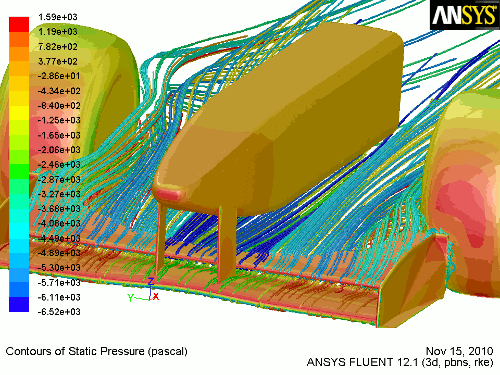
RBF Morph has been present at the EnginSoft International Conference 2011 on the 20th and 21th of October in Verona – Fiera Verona with the paper Fluid Structure Interaction (FSI) with RBF Morph: a Generic Formula 1 Front End by M. E. Biancolini and with the poster VMTK – Fluent – RBF Morph: A New Workflow For Hemodynamics Applications by R. Ponzini, M.E. Biancolini, L. Antiga.
Find papers and publications in the Presentations and Proceedings Area; a direct link to the paper “Fluid Structure Interaction (FSI) with RBF Morph Generic Formula 1 Front Wing” is anyway available.
Abstract: Fluid Structure Interaction (FSI) with RBF Morph: a Generic Formula 1 Front End by M. E. Biancolini

CFD calculations are usually performed considering the undeformed wing configuration (i.e. rigid parts).
When important effects are observed (wing deformation and rotation) the CFD model should be updated to the deformed configuration. Even a slight deformation can have a dramatic effect on performances (Drag, Lift, Tyre-Wing interaction,…).
A feasible solution is given by Fluent + RBF Morph: the CFD model parameterized using modal shapes becomes flexible.
Modal shapes are first calculated using FEA, then the Fluid mesh is parameterized using modal shapes by RBF Morph each mode is stored as a standard shape modifier.
Amplifications of each mode are obtained dividing the modal force (integrated directly onto the CFD mesh) for the squared circular frequency and then used for CFD mesh updating.
Usually the shape is updated during CFD iterations (typical updating interval is 25).
Modal embedding method results are very close to full two ways coupling (3% error) using the first 5 modes; the effect of speed on drag and downforce is studied using the proposed approach.
Abstract: VMTK – Fluent – RBF Morph: A New Workflow For Hemodynamics Applications by R. Ponzini, M.E. Biancolini, L. Antiga

Engineering applications involving biological fluids have highly transversal requirements in terms of domain definition from clinical images, complex flow conditions, fluid rheological properties, structure motion and deformation, visualization and post-processing of the results.
For these reasons, and thanks to the enormous developments of computational sciences, a computer-aided–engineering workflow seems to be a possible elective environment where to perform hemodynamics studies and medical device design.
Today a large part of the technological requirements needed to tackle these problems in a computational environment are already available in open source and/or commercial software.
Nevertheless, success still strongly depends on technical knowledge and best practice or in other word ideas must be translated into stable and usable implementations.
In this work we present a new workflow based on three fully validated software used to elegantly fulfill the requirements related to hemodynamics: the Vascular Modeling Toolkit (VMTK) for the pre-processing step; the RBF Morph mesh morphing tool to impose changes to the vascular anatomy; Ansys Fluent as Navier-Stokes solver and CFD modeler.
As a first test case we focused our attention on the study of a subject-specific carotid bifurcation being this anatomical site of major interest in hemodynamics.



